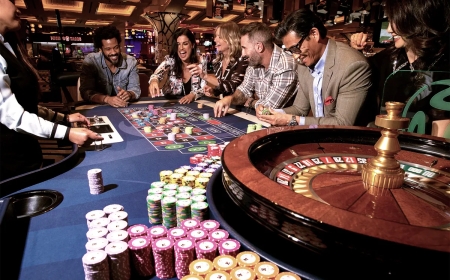High-Rise vs. Brownstone: NYC Architecture’s Influence on Web Design Trends
Wondering what’s trending in modern web design? Check this blog on NYC architecture’s influence on web design with its high-rise aesthetics and brownstones.

Walk down any neighborhood in NYC, and you’ll see the collision of eras. Sleek high-rise towers standing side by side with rows of classic brownstones. This cityscape contrast is what makes New York City visually unforgettable. However, this influence isn’t limited to the skyline only. With emerging trends, we can see it's seeping into the digital world, right into the web designers’ minds, redefining how they think, structure, and express creativity. Wondering how? Read on!
NYC architecture’s influence on web design is no longer something that'll gonna happen; it’s happening now. We live in an era where a website's aesthetics can directly influence trust in milliseconds. 42% of Americans feel too embarrassed to purchase products from a poorly designed website. Hence, it’s no surprise that designers look to the physical world for inspiration. The physical world of New York City is rich, textured, and culturally influential, which makes it ideal for modern web design.
Wondering how buildings, materials, and the city rhythm of NYC are shaping the future of digital creativity? In this blog, let’s explore the phenomenon of NYC architecture’s aesthetics for web design and draw a quick comparison between high-rise modernism and brownstone warmth.
Brownstone vs. High-Rise Aesthetics: What Defines the Web Design Culture in New York City?
Before we dive straight into the comparison, let’s first simplify the concept of NYC’s high-rise and brownstone aesthetics from the perspective of modern web design.
How is NYC’s High-Rise Becoming the New York Web Design Inspiration?
NYC’s high-rises are more than just steel and glass; they’re a symbol of ambition. They represent precision, progress, and clarity, inspiring digital environments directly. Here’s how:
-
Cool-toned color pallets inspired by concrete, metals, and polished surfaces.
-
Modular grid layouts to echo the stacked floors of skyscrapers.
-
Vertical storytelling through long-scrolling webpages.
-
Minimalist, sleek UI mirroring the simplicity of glass and steel.
-
Uncluttered visuals with high clarity evoking future-facing web design aesthetics.
How NYC’s Brownstone Warmth Inspires NY Web Designers?
Unlike high-rise buildings, brownstones have a completely different soul. Built from sandstone, limestone, and brick, they radiate the history of New York City. They’re rich with character and the OG charm of NYC’s neighborhoods. Here’s how they inspire web designers:
-
Warm, earthy color pallets (brick red, deep wood tones, and sandstone beige)
-
Narrative-driven layouts foster an organic and inviting feeling.
-
Typography with personality reminiscent of “classic signage.”
-
Textured background resembling stone or handcrafted materials.
-
Branding with a greater focus on authenticity and emotional resonance.
A Quick Comparison of Modern vs Classic Design in NYC websites for 2026
Let’s compare high-rise modernism and timeless brownstone side by side in the table below as one of the top NYC architecture and web design trends:
|
Category |
High-Rise Influence |
Brownstone Influence |
|
Layout Structure |
Rigid grids, vertical flow, and precise alignment; creating clarity and order |
Softer composition, human-scale spacing, and layered sections; creating natural storytelling |
|
Visual Hierarchy |
Prioritizes a clean yet sharp hierarchy to help users scan and absorb content quickly |
Prioritizes gentle and narrative hierarchy to guide users through a more emotional experience |
|
Depth and Texture |
Minimal texture with defined, high-contrast shadows; sleek digital presence |
Subtle, tactile texture with soft and diffused shadows; cozy, analog-inspired digital presence |
|
Overall Designing Mood |
Offers a sleek, modern, and ambitious tone aligned with scale and innovation |
Offers an intimate and warm character-rich tone aligned with heritage and authenticity |
|
Color Direction |
Usually relies on polished, cool tones; reinforcing modernity and minimalism |
Mostly relies on warm, earthy tones; reinforcing personality, comfort, and approach |
|
Typography Style |
Modern Sans-Serif to enhance clarity and precision |
Serif or Soft Sans-Serif to enhance warmth and visual characters |
|
Brand Impression |
Signals professionalism, confidence, and forward-thinking identity |
Signals trust, community, heritage, and personal connection |
|
UX Priorities |
Greater focus on speed, functional clarity, and friction |
Focused mostly on comfort, emotional engagement, and narrative flow |
|
UI and Shape Language |
Features crisp lines, minimal ornamentation, and geometric consistency |
Features rounded edges and textured accents to foster an organic, handcrafted feel |
|
Motion and Interactions |
Uses fast and clean transitions; emphasis on efficiency and structure |
Uses gentle, inviting animations; emphasis on connection and immersion |
|
Best for |
Tech startups, SaaS platforms, FinTech firms, corporate services, luxury real estate, digital agencies, and modern retail brands |
Boutique retail, hospitality, artisan shops, restaurants/cafes, cultural institutions, local services, and lifestyle brands |
There’s no winner of this debate, as each of these built aesthetics plays a pivotal role. You gotta understand what type of design elements you’re looking for in your website development project.
Still feeling stuck? Collaborating with a professional web design company in New York, like Unified Infotech, can help you. Over 15 years of experience and skills, they can help you design your web solutions and develop them as well.
How to Incorporate NYC’s Architecture into Modern Web Designs?
Understanding the influence of NYC’s architecture on web design means understanding how web designers of NYC borrow directly from the built environment. Let’s see how NYC designers are incorporating these architectural principles in UI/UX design:
1. Architectural Rhythm
NYC buildings come with a specific rhythm, such as aligned facades, repeating windows, and consistent proportions. Here’s how designers are mirroring these patterns in websites:
-
Spacing rules
-
Structured hierarchy
-
Column systems
-
Symmetrical layouts
2. Material-Inspired Colors and Texture Choices
Designers incorporate colors inspired by the urban materials of NYC into their best practices:
-
Chestnut brown or brick red to add warmth, intimacy, and NYC’s history.
-
Concrete grey to bring a modern, neutral, and high-rise feel.
-
Steel silver or glass blue to promote futuristic minimalism.
-
Sandstone beige to give the site a soft, elegant, and grounded feel.
3. Motion Inspired by the City Energy
Movement is the main part of NYC’s identity. Here’s how designers are replicating it online:
-
Soft fade-ins to reflect natural light or brownstone entryways
-
Parallax scrolling that mimics moving upward through a skyline
-
Crisp slide animations to evoke corporate, high-rise precision
4. Light, Shadow, and Depth
NYC’s skyscrapers catch light differently than brownstones. Here’s how web designers signal emotion with depth:
-
Soft, ambient shadows to evoke a residential and cozy feeling
-
Sharp, high-contrast shadows reflecting the modern cityscape of NYC
Wrapping Up: NYC’s Building Architecture as a Web Design Language
NYC’s architectural landscape is much more than just a scenic view. It’s a language in the realm of modern web design. NYC’s high-rise aesthetics bring clarity, structure, and ambition to digital design, while brownstone aesthetics bring the OG charm of NYC’s neighborhoods via warmth, authenticity, and narratives. We hope this blog post will give you an insight into the NYC architecture’s influence on web design and how designers are incorporating these into their best practices. Let us know if you have any suggestions or confusion on the same.













































